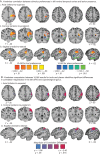Domain-Specific Diaschisis: Lesions to Parietal Action Areas Modulate Neural Responses to Tools in the Ventral Stream
- PMID: 30169596
- PMCID: PMC6933536
- DOI: 10.1093/cercor/bhy183
Domain-Specific Diaschisis: Lesions to Parietal Action Areas Modulate Neural Responses to Tools in the Ventral Stream
Abstract
Neural responses to small manipulable objects ("tools") in high-level visual areas in ventral temporal cortex (VTC) provide an opportunity to test how anatomically remote regions modulate ventral stream processing in a domain-specific manner. Prior patient studies indicate that grasp-relevant information can be computed about objects by dorsal stream structures independently of processing in VTC. Prior functional neuroimaging studies indicate privileged functional connectivity between regions of VTC exhibiting tool preferences and regions of parietal cortex supporting object-directed action. Here we test whether lesions to parietal cortex modulate tool preferences within ventral and lateral temporal cortex. We found that lesions to the left anterior intraparietal sulcus, a region that supports hand-shaping during object grasping and manipulation, modulate tool preferences in left VTC and in the left posterior middle temporal gyrus. Control analyses demonstrated that neural responses to "place" stimuli in left VTC were unaffected by lesions to parietal cortex, indicating domain-specific consequences for ventral stream neural responses in the setting of parietal lesions. These findings provide causal evidence that neural specificity for "tools" in ventral and lateral temporal lobe areas may arise, in part, from online inputs to VTC from parietal areas that receive inputs via the dorsal visual pathway.
Keywords: anterior intraparietal sulcus; dorsal stream; fMRI; manipulable objects; neurosurgery; supramarginal gyrus; tools; ventral stream; voxel-based lesion-activity mapping; voxel-based lesion-symptom mapping.
© The Author(s) 2018. Published by Oxford University Press. All rights reserved. For Permissions, please e-mail: journals.permissions@oup.com.
Figures




Similar articles
-
Gesturing tool use and tool transport actions modulates inferior parietal functional connectivity with the dorsal and ventral object processing pathways.Hum Brain Mapp. 2019 Jul;40(10):2867-2883. doi: 10.1002/hbm.24565. Epub 2019 Mar 21. Hum Brain Mapp. 2019. PMID: 30900321 Free PMC article.
-
Visual processing of manipulable objects in the ventral stream is modulated by inputs from parietal action systems.bioRxiv [Preprint]. 2025 Jun 3:2025.06.01.657280. doi: 10.1101/2025.06.01.657280. bioRxiv. 2025. PMID: 40501973 Free PMC article. Preprint.
-
Resilience to the contralateral visual field bias as a window into object representations.Cortex. 2016 Aug;81:14-23. doi: 10.1016/j.cortex.2016.04.006. Epub 2016 Apr 13. Cortex. 2016. PMID: 27160998 Free PMC article.
-
A brief comparative review of primate posterior parietal cortex: A novel hypothesis on the human toolmaker.Neuropsychologia. 2017 Oct;105:123-134. doi: 10.1016/j.neuropsychologia.2017.01.034. Epub 2017 Jan 31. Neuropsychologia. 2017. PMID: 28159617 Free PMC article. Review.
-
Top-down and bottom-up attention to memory: a hypothesis (AtoM) on the role of the posterior parietal cortex in memory retrieval.Neuropsychologia. 2008;46(7):1828-51. doi: 10.1016/j.neuropsychologia.2008.03.022. Epub 2008 Apr 8. Neuropsychologia. 2008. PMID: 18471837 Review.
Cited by
-
Gesturing tool use and tool transport actions modulates inferior parietal functional connectivity with the dorsal and ventral object processing pathways.Hum Brain Mapp. 2019 Jul;40(10):2867-2883. doi: 10.1002/hbm.24565. Epub 2019 Mar 21. Hum Brain Mapp. 2019. PMID: 30900321 Free PMC article.
-
Neural encoding and functional interactions underlying pantomimed movements.Brain Struct Funct. 2021 Sep;226(7):2321-2337. doi: 10.1007/s00429-021-02332-6. Epub 2021 Jul 10. Brain Struct Funct. 2021. PMID: 34247268 Free PMC article.
-
Causal Lesion Evidence for Two Motor Speech Coordination Networks in the Brain.bioRxiv [Preprint]. 2025 Jun 6:2025.06.05.658124. doi: 10.1101/2025.06.05.658124. bioRxiv. 2025. PMID: 40501547 Free PMC article. Preprint.
-
Lesion-network mapping in task-dependent frequencies uncovers remote consequences of focal damage.Imaging Neurosci (Camb). 2025 Apr 30;3:imag_a_00557. doi: 10.1162/imag_a_00557. eCollection 2025. Imaging Neurosci (Camb). 2025. PMID: 40800916 Free PMC article.
-
Temporal differences and commonalities between hand and tool neural processing.Sci Rep. 2023 Dec 14;13(1):22270. doi: 10.1038/s41598-023-48180-8. Sci Rep. 2023. PMID: 38097608 Free PMC article.
References
-
- Allison T, McCarthy G, Nobre A, Puce A, Belger A. 1994. Human extrastriate visual cortex and the perception of faces, words, numbers, and colors. Cereb Cortex. 4:544–554. - PubMed
-
- Almeida J, Amaral L, Garcea FE, Aguiar de Sousa D, Xu S, Mahon BZ, Pavāo Martins I. 2018. Visual and visuomotor processing of hands and tools as a case study of cross talk between the dorsal and ventral streams. Cogn Neuropsychol. 24:1–16. - PubMed
Publication types
MeSH terms
Grants and funding
LinkOut - more resources
Full Text Sources
Other Literature Sources

